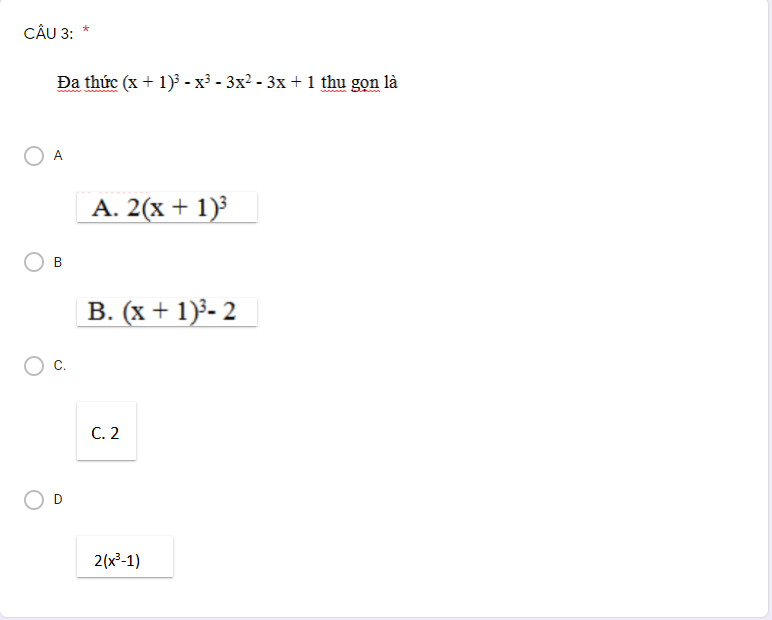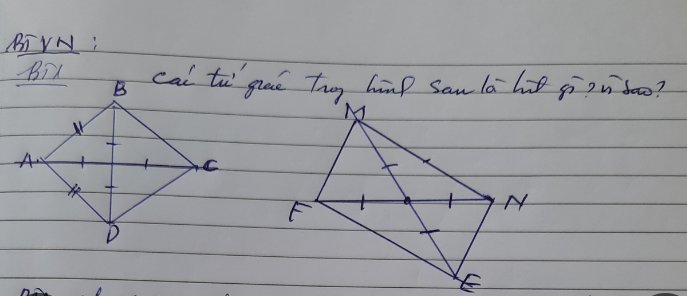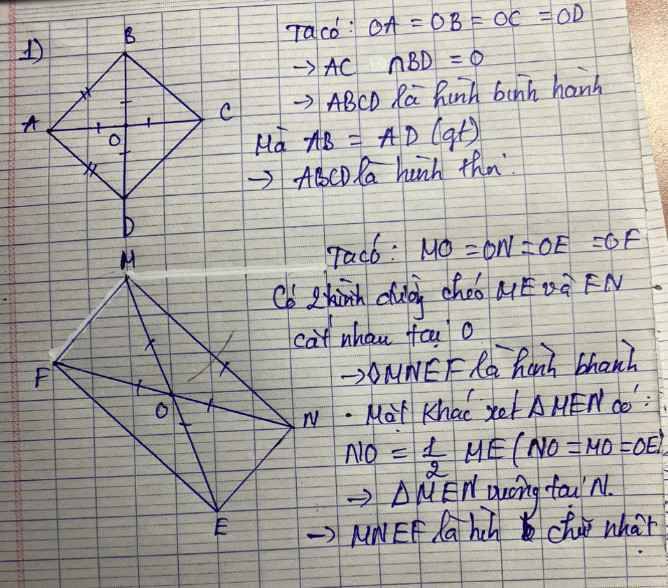Hãy nhập câu hỏi của bạn vào đây, nếu là tài khoản VIP, bạn sẽ được ưu tiên trả lời.

\(P=\left(\dfrac{x^2+1}{x^2-9}-\dfrac{x}{x+3}+\dfrac{5}{3-x}\right):\left(\dfrac{2x+10}{x+3}-1\right)\)
\(=\left(\dfrac{x^2+1}{\left(x-3\right)\left(x+3\right)}-\dfrac{x\left(x-3\right)}{\left(x-3\right)\left(x+3\right)}-\dfrac{5\left(x+3\right)}{\left(x-3\right)\left(x+3\right)}\right):\left(\dfrac{2x+10}{x+3}-\dfrac{x+3}{x+3}\right)\)
\(=\left(\dfrac{x^2+1-x^2+3x-5x-15}{\left(x-3\right)\left(x+3\right)}\right):\left(\dfrac{2x+10-x-3}{x+3}\right)\)
\(=\left(\dfrac{-2x-14}{\left(x-3\right)\left(x+3\right)}\right):\left(\dfrac{x+7}{x+3}\right)\)
\(=\dfrac{-2\left(x+7\right)}{\left(x-3\right)\left(x+3\right)}.\dfrac{x+3}{x+7}\)
\(=\dfrac{-2}{x-3}\)
đk : x khác -3 ; 3 ; -7
\(P=\left(\dfrac{x^2+1+x\left(x-3\right)+5x+15}{x^2-9}\right):\left(\dfrac{2x+10-x-3}{x+3}\right)\)
\(=\dfrac{2x^2+1+2x+15}{x^2-9}:\dfrac{x+7}{x+3}=\dfrac{2x^2+2x+16}{\left(x-3\right)\left(x+7\right)}\)

a; Xét ΔBAC có MN//BC
nên AM/AB=AN/AC
=>AM/20=15/20
=>AM=15
b: Xét ΔABC có MN//BC
nên AN/NC=AM/MB
=>AN/NC=3/2
=>AN/3=NC/2
Áp dụng tính chất của dãy tỉ số bằng nhau, ta được:
\(\dfrac{AN}{3}=\dfrac{NC}{2}=\dfrac{AN+NC}{3+2}=\dfrac{5}{5}=1\)
Do đó: NC=2
c: Xét ΔBCA có MN//BC
nên MN/BC=AM/AB
=>MN/6=8/12=2/3
hay MN=4


\(ĐK:x\ne0\)
\(\dfrac{x-1}{3}+\dfrac{x+3}{x}=2\)
\(\Leftrightarrow\dfrac{x\left(x-1\right)+3\left(x+3\right)}{3x}=\dfrac{6x}{3x}\)
\(\Leftrightarrow x\left(x-1\right)+3\left(x+3\right)=6x\)
\(\Leftrightarrow x^2-x+3x+9-6x=0\)
\(\Leftrightarrow x^2-4x+9=0\)
Ta có: \(x^2-4x+9=x^2-4x+4+5=\left(x-2\right)^2+5\ge5>0\)
Vậy pt vô nghiệm

a: ABCD là hình thang có MN//AB
nên AM/MD=BN/NC
=>AM/4=BN/1=6/5
=>AM=4,8cm
b: ABCD là hình thag có MN//AB//CD
nên BN/NC=AM/MD
=>4/2=AM/3
=>AM=6cm
=>AD=9cm
c; BN/NC=AM/MD=1
=>BN=5cm

a: ĐKXĐ: x<>0; x<>1(A)
(B): x<>0; x<>3
(C): x<>2; x<>-2
b: \(A=\dfrac{2\left(x-1\right)}{x\left(x-1\right)}=\dfrac{2}{x}\)
\(B=\dfrac{2\left(x-3\right)}{x\left(x-3\right)}=\dfrac{2}{x}\)
\(C=\dfrac{3\left(x-2\right)}{\left(x-2\right)\left(x+2\right)}=\dfrac{3}{x+2}\)
c: Khi x=0 thì A và B không xác định
Khi x=0 thì C=3/2
Khi x=3 thì B ko xác định, A=2/3; C=3/5
\(a,DKXD:\)
\(+x^2-x\ne0\Leftrightarrow x\ne0;1\)
\(+x^2-3x\ne0\Leftrightarrow x\ne0;3\)
+\(x^2-4\ne0\Leftrightarrow x\ne\pm4\)
\(b,\)
\(\dfrac{2x-2}{x^2-x}=\dfrac{2\left(x-1\right)}{x\left(x-1\right)}=\dfrac{2}{x}\)
\(\dfrac{2x-6}{x^2-3x}=\dfrac{2\left(x-3\right)}{x\left(x-3\right)}=\dfrac{2}{x}\)
\(\dfrac{3x-6}{x^2-4}=\dfrac{3\left(x-2\right)}{\left(x-2\right)\left(x+2\right)}=\dfrac{3}{x+2}\)
\(c,\)
Vì phân thức 1,2 cùng kết quả nên mk lm 1 cái thôi nhé
+ Thay \(x=0\) vào \(\dfrac{2}{x}\Leftrightarrow\dfrac{2}{0}=0\)
Thay \(x=3\) vào \(\dfrac{2}{x}\Leftrightarrow\dfrac{2}{3}\)
+ Thay \(x=0\) vào \(\dfrac{3}{x+2}\Leftrightarrow\dfrac{3}{0+2}=\dfrac{3}{2}\)
Thay \(x=3\) vào \(\dfrac{3}{x+2}\Leftrightarrow\dfrac{3}{3+2}=\dfrac{3}{5}\)

a, Áp dụng định lý Ta-lét ta có:
\(\dfrac{AD}{DB}=\dfrac{AE}{EC}\Rightarrow\dfrac{4}{x}=\dfrac{5}{10}\Rightarrow x=4:\dfrac{1}{2}\Rightarrow x=8\)
Áp dụng hệ quả định lý Ta-lét ta có:
\(\dfrac{AE}{AC}=\dfrac{DE}{BC}\Rightarrow\dfrac{5}{15}=\dfrac{6}{y}\Rightarrow y=6:\dfrac{1}{3}\Rightarrow y=18\)
b, Áp dụng định lý phân giác ta có:
\(\dfrac{DB}{DC}=\dfrac{AB}{AC}\Rightarrow\dfrac{5}{6}=\dfrac{10}{x}\Rightarrow x=10:\dfrac{5}{6}\Rightarrow x=12\)






C
bữa sau bạn nhớ giải thích nữa nha chớ mình không biết tại sao ra đáp án đó đâu